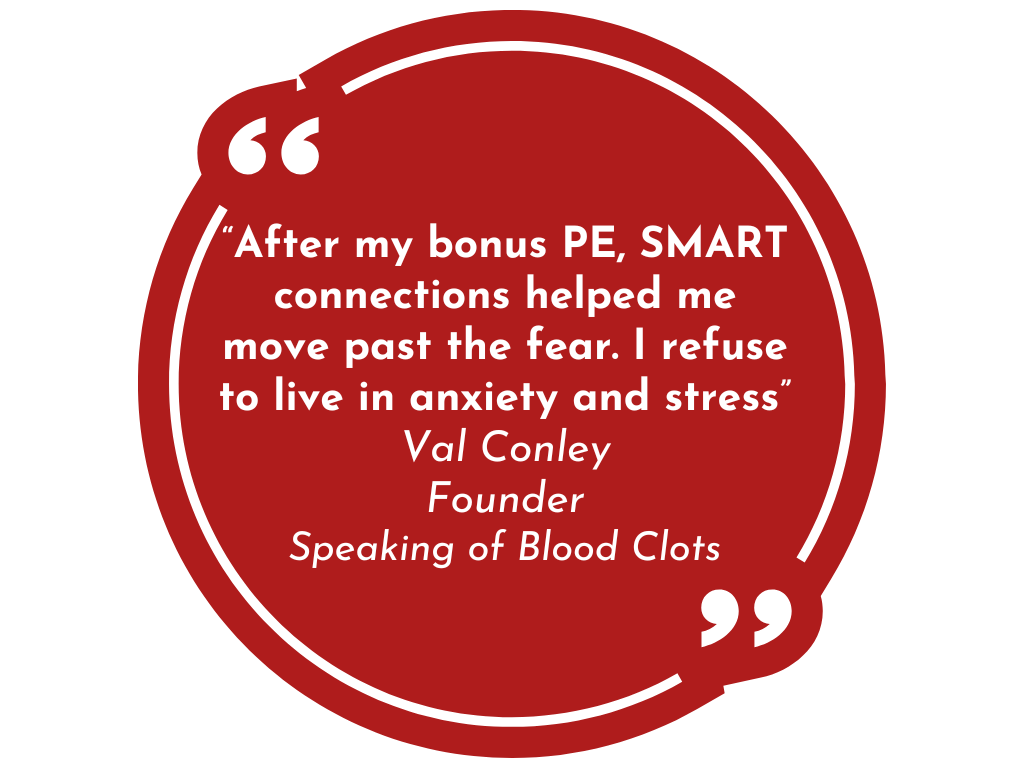After my first pulmonary embolism, I joined online support groups and that initial education was invaluable.
But as I progressed in my physical and mental recovery, entering new chapters of life (hello, menopause!), I realized online support groups were no longer a good fit for me.
My experience tells me that grief and loss are things you sit with for awhile, but you can’t stay there.
You have to move to live.
So my doc suggested building SMART Connections.
what is a SMART Connections ?
SMART connections are based on the principles of SMART goals – Specific, Measurable, Achievable, Relevant, and Time-bound.
SMART Connections empower you to take action.
It’s the action that drives so many important parts of blood clot prevention and recovery.
As well as living in faith and confidence that everything is going to be okay.
THE TRUE POWER OF SMART CONNECTIONS is how they change you
SMART connections cultivate adaptability and resilience.
Developing a mindset and skill set that enables you to thrive in diverse and dynamic environments.
Here’s how SMART connections work:
Goal Setting Encourages Learning: The process of setting specific, measurable, and achievable goals requires individuals to continually learn and acquire new knowledge or skills.
This helps you become your best self advocate.
Feedback and Refinement Support Growth: SMART connections often involve receiving feedback on progress toward goals.
Constructive feedback allows individuals to refine their approaches.
Adherence to Timelines Builds Discipline: The time-bound aspect of SMART goals promotes discipline and time management.
As individuals consistently adhere to timelines, they develop a disciplined approach to their endeavors.
Instilling a sense of structure and order, which is helpful when adopting lifestyle changes to reduce your clotting risks or being compliant with medications and follow-up appointments.
Collaboration Enhances Problem-Solving: SMART connections often involve collaboration and shared problem-solving.
This exposes individuals to diverse ways of thinking and problem-solving strategies and helps pave the way for patient-centered care.
Achieving Goals Boosts Confidence: Successfully achieving SMART goals contributes to a sense of accomplishment and increased self-confidence.
Confidence is a key factor in adaptability.
Individuals who believe in their ability to overcome challenges are more likely to approach new situations with resilience.
It helps you navigate health care and allows you to trust your body again to move forward.
Mindset Shifts Toward Growth: Engaging in SMART connections often requires individuals to adopt a growth mindset.
Seeing challenges as opportunities for learning and improvement, especially when it comes to your health.
Cultivation of Positive Habits: SMART connections often involve the development of positive habits that can support health and wellness goals.
Habits, such as consistency and prioritization, contribute to an overall lifestyle of adaptability and sustainability.
Individuals with well-established positive habits are better equipped to navigate change.
Called the “intention-behavior gap,” numerous studies have demonstrated that intention to change behavior alone does not often result in actual behavior change.
Intention precedes action; therefore, one must act on one’s intentions in order to change behavior.
PMID: 31662729
One of the blessings of being a blood clot survivor is understanding that the purpose and depth of connections is far greater than the amount of connections.
Build connections that will help you move forward in your health and wellness goals.
